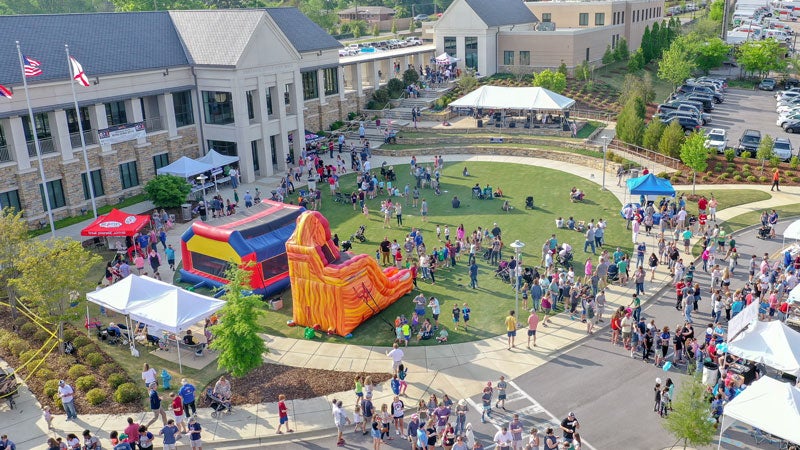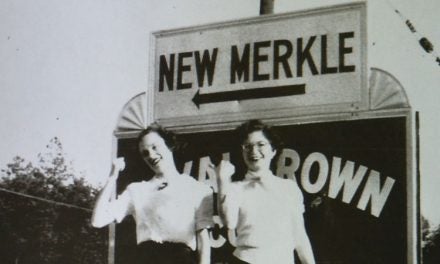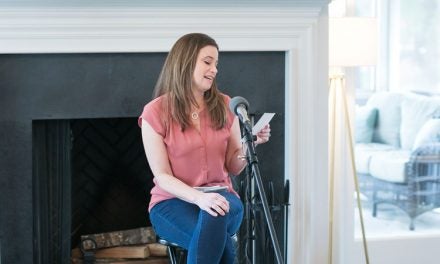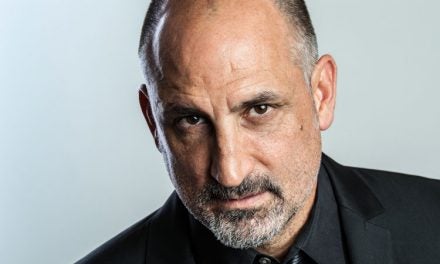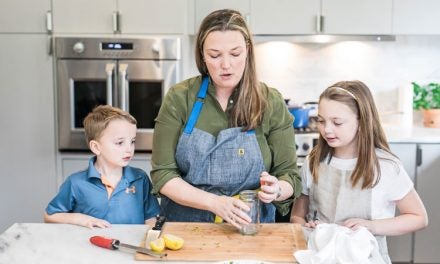These Leadership Vestavia Hills projects are transforming the community years after their inception.
Wing Ding
Year Launched: 2011
Original Project Team Members: J. Dennis, Julie Harper, Jonathan Nelson, Lindy Walker, Kim Hauser, Kristi McHale, with Rick Rice, Rebecca Olsen and Karen Odle as advisors
Come April 4, 2020, Roger Steur will round up 150 pounds of chicken wings to take to Vestavia Hills City Hall. He and his team will arrive around 6 a.m. to start frying them and dipping them in honey bourbon barbecue sauce. They’ll be sure to follow the rules—no added meat—but for a crowd pleaser they’ll wrap some wings in bacon, securing the fatty strips with toothpicks before the frying. After all, “You could put bacon on a flip flop and it would taste pretty good,” Roger jokes.
For some of the past nine years Roger and his team from Method Mortgage’s wings have placed first per the judges of the annual Wing Ding event and taken home the People’s Choice award. And when they are lucky, they have taken a break from the fryer to taste the other 20-plus teams’ flavorings of everything from garlic Asian to pineapple habanero. “It’s pretty fun to see different varieties and no two are alike,” Roger says.
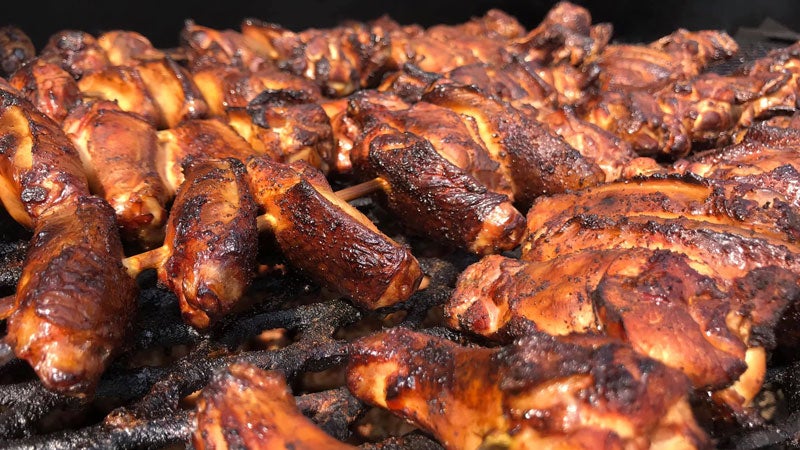 Since its start as a Leadership Vestavia Hills project in 2011, Wing Ding has, of course, been about the wings—grilled, smoked or fried. But that’s not all. Last year the event raised $12,837 for the Cystic Fibrosis Foundation, an organization whose mission ties closely with the founding organizers’ friends in the community, and since it started it’s raised $56,644 for the foundation. It’s also raised money for Youth Leadership Vestavia Hills.
Since its start as a Leadership Vestavia Hills project in 2011, Wing Ding has, of course, been about the wings—grilled, smoked or fried. But that’s not all. Last year the event raised $12,837 for the Cystic Fibrosis Foundation, an organization whose mission ties closely with the founding organizers’ friends in the community, and since it started it’s raised $56,644 for the foundation. It’s also raised money for Youth Leadership Vestavia Hills.
But the event’s original mission as a Leadership Vestavia Hills project was principally to bring the entire Vestavia Hills community out to celebrate together. Unlike an event like the Exceptional Foundation Chili Cookoff with teams from all over Birmingham, Wing Ding was to be focused on its own neighborhood. “We try to make it a very Vestavia centric event in the heart of the city on 31,” says Donnie Winningham, who has volunteered with the event since 2013.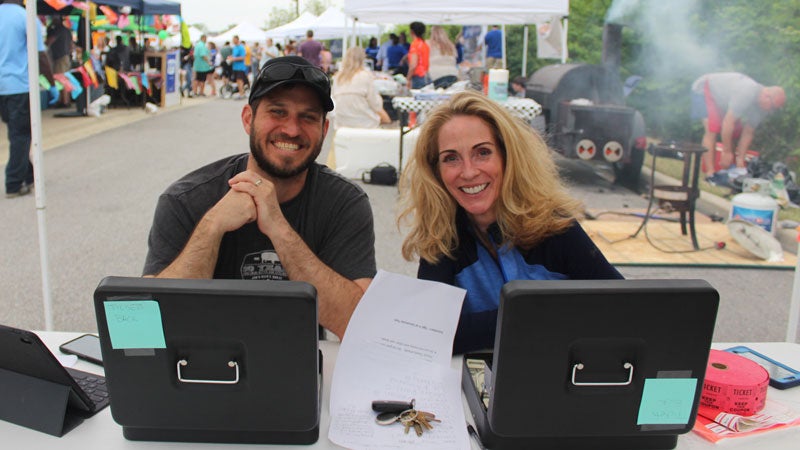
Wing Ding has evolved too, moving from the Vestavia City Center to the new City Hall, from lunch time to evening time, from June to May to April. But it’s still focused on Vestavia, still organized by Leadership Vestavia Hills with a large team working behind the scenes and still full of mouthwatering wings.
“There’s always the fun of local community people coming together to have competition with each other, seeing your neighbors and meeting new people,” says Ann Hamiter, who helped organize the event for several years. “It’s a great example of citizens forming a community event.”
Which team’s wings will place first this year? You’ll have to come out on April 4 to find out.
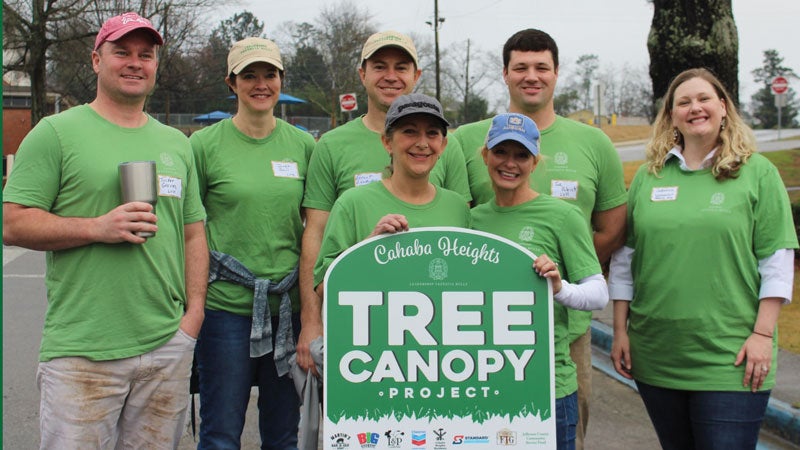 Cahaba Heights Tree Canopy Project
Cahaba Heights Tree Canopy Project
Year Launched: 2018
Original Project Team Members: Brian Burns, Merryl Cooper, Ashley Gann, Don Simmons & Rusty Weaver
Snap! Snap! Snap! Susan Ray vividly remembers the sound she heard outside her home on April 27, 2011 as winds up to 120 mph swept through. “It sounded like trees were landing on our house,” she recalls of the night a Category 2 tornado came through Cahaba Heights, but fortunately they weren’t, at least at her house. “When we went outside, it looked like a war zone. Next door a tree had split the house in half, and two houses on our street had to be torn down and rebuilt.”
In the weeks and month that followed, each time Susan and her kids drove back across 280 to their neighborhood they saw the barrenness along the streets that were once heavily forested with hardwoods and pine trees. “It literally looked like a different neighborhood,” Susan explains.
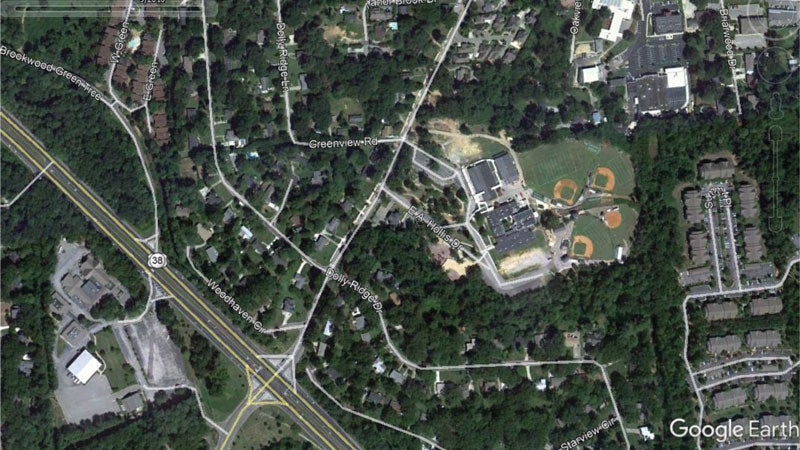
Cahaba Heights Before the 2011 Tornado
Six years later Susan got a flier about someone giving away free trees to help reforest the neighborhood. She thought it was a scam at first, but as it turns out it wasn’t. Leadership Vestavia Hills was sponsoring a free tree-planting program for the neighborhood across from Vestavia Hills Elementary Cahaba Heights, and residents could request a tree for their yard. That February in 2018 the group planted 14 trees.
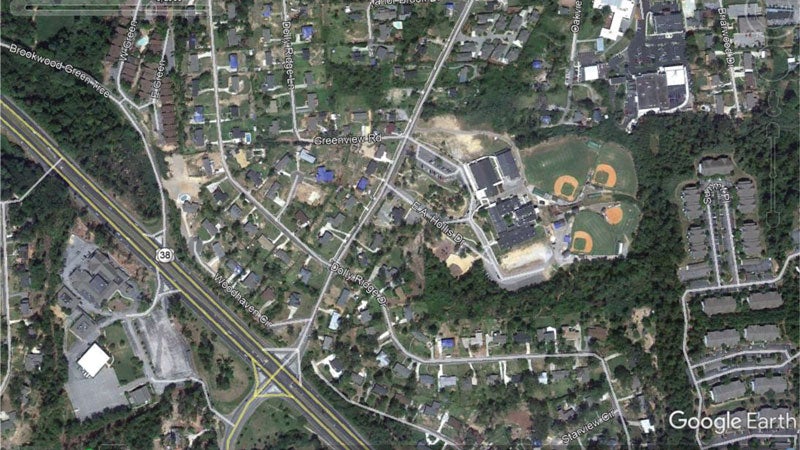
Cahaba Heights After the 2011 Tornado
The next Leadership Vestavia Hills class to take on the project set out to up that number, and that’s what they did, planting another 30 Nuttall Oaks and Red Maples this spring thanks to a set of businesses who joined the effort. Leaf & Petal sold them trees at cost, which cut the price tag in half. Fig Tree Café provided breakfast for the volunteers, Martin’s Bar-B-Que provided lunch, the Chevron station provided water and Gatorade, and Cahaba Heights Hardware donated mulch and soil conditioner. And among the ranks of the tree planters were Vestavia Hills High School football players.
“It was so cool to see how the businesses in Cahaba Heights came together, and how the students at the high school came together,” say Katherine McRee, a member of the LVH team behind this year’s project along with Tucker Groves, Janet Ball, Terri Yates, Joe Patrick, Grant Lauderdale and Catherine Alexander. “When you see the visual of how many trees were actually lost, it makes perfect sense to keep the project going even further. We could plant 1,000 trees and it still wouldn’t cover the amount of trees lost.”
Today every time Susan crosses 280 back into Cahaba Heights what she notices is the newly planted trees in her neighbors’ yards and her own too. “(It was encouraging) just to know the community cared and it wasn’t just us disheartened by the barren landscape,” she says.
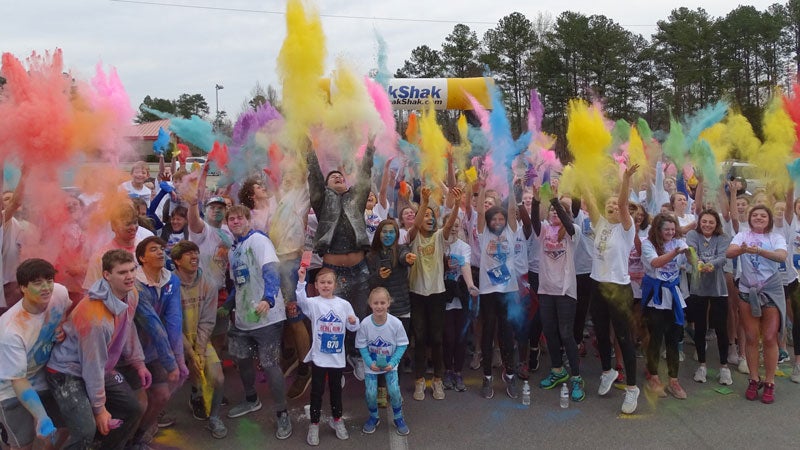 Youth Leadership Vestavia Hills
Youth Leadership Vestavia Hills
Year Launched: 2005
Original Project Team Members: Garry Atkins, Kelly Bottcher, Cindy Brown, Bryan Gunn, Ann Jones, Kym Prewitt & Sally Young
When Kym Prewitt graduated from VHHS in 1982, she had 310 classmates, but today the school has grown to around 2,000 students total. “You have to be more intentional in a big sea,” Kym says. “It’s harder to navigate those waters.” And that’s exactly why Youth Leadership Vestavia Hills exists, thanks to facilitators like Kym, Emily Erwood, Kelly Bottcher and Lindy Walker.
The original idea as a Leadership Vestavia Hills project 15 years ago was to create a leadership program for youth similar to LVH, but since then it has evolved to best fit the needs of the students and sprung from a LVH project to become part of the high school’s curriculum. The team behind Youth Leadership didn’t want to just work with the top 20 to 30 students who were already in leadership positions. “We wanted to include as many students as possible because we believe every student is a leader and we wanted to teach them skills to be an effective positive leader,” Kym explains. “We wanted this big growing school to have a small school feel by teaching students to better connect with one another.”
The first year around 40 students were involved, the second year around 120, and now they work with around 240 students each year and more than 700 total—all who are working to change the culture of the school for the better. Often that looks like small acts of kindness no adult ever sees, like a student inviting someone who is alone to sit at the lunch table with him or her. “We want (our students) to walk into a room and recognize a need and take the initiative to meet that need, especially when it comes to peers needing to feel connected and feel valued,” Kym says.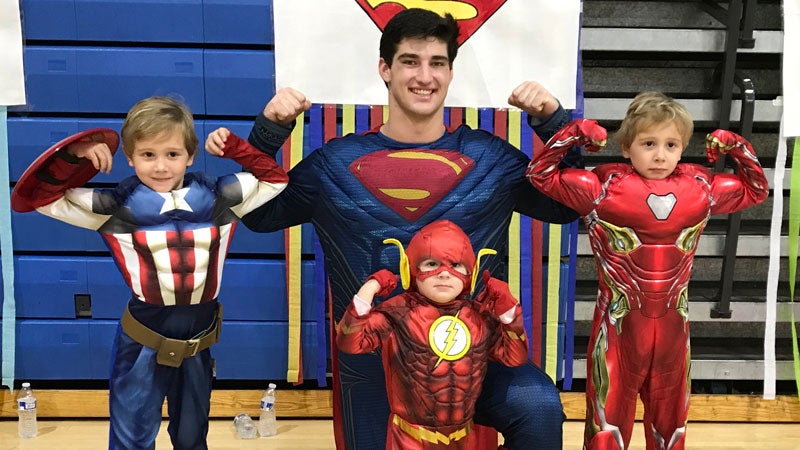
Other efforts are more organized. A New Student Committee sponsored by Sarah Kaiser pairs Youth Leadership students with new students to tour them around the school, answer their questions and keep in touch as they go through the school year. Other students mentor with elementary students through a Big Brothers Big Sisters program, and around 80 students each year participate in Youth Leadership classes in two different levels during the school day.
Through the Bridges program, high school students visit sixth-grade classes to share stories about their struggles in middle school and what they learned from them. “They are sharing real stories and letting these students know they are not the only one who has ever felt alone or like you are invisible,” Kym says. “It’s tremendous what it does for them.”
Like their adult counterpart, the Youth Leadership students are always incubating new ideas too. As just one example, in 2017 they developed an award-winning Student Life app to provide access to all the school-related information they need. This was the first app of its kind in the country.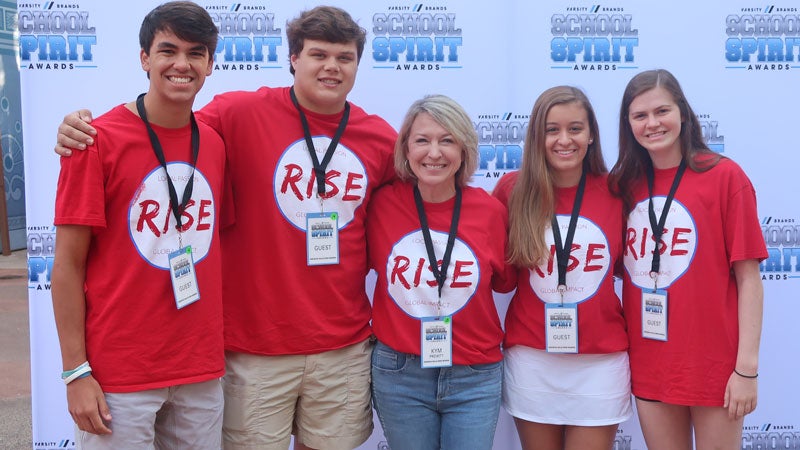
Perhaps the most public-facing part of Youth Leadership, RISE (Rebels Impact through Service and Engagement) raises money for the UAB Comprehensive Cancer Center each spring through a Rebel Run, Concert for a Cure and their flagship RISE Day full of fun and festivities. Last year more than 220 students served on committees for RISE, and more than 1,000 were on service teams. It was also named by Varsity Brands as a Top 10 finalist in the category of Most Spirited Community Service Project in the nation.
And all of that, we’d say, is certainly intentionality in a big sea.
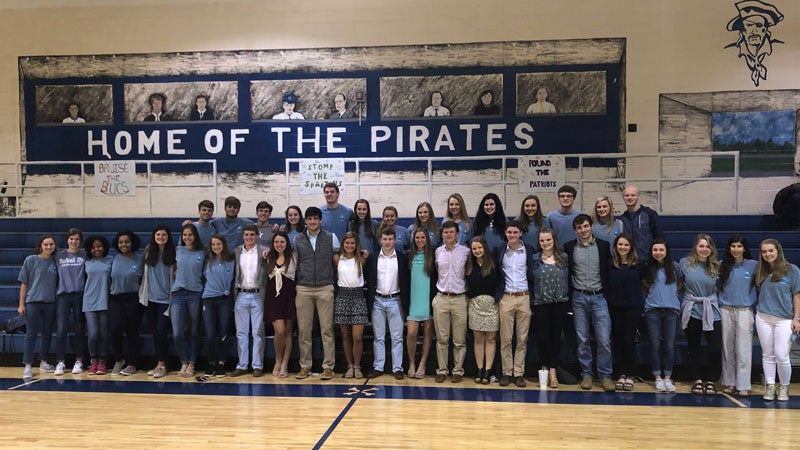 Help the Hills
Help the Hills
Year Launched: 2014
Original Project Team Members: Dan Pahos, David Martin, Shera Grant, Tracy Davis, Shanta Owens, Jennifer Philpot & Charles Shah
Brad Blount was an all-star Vestavia athlete like many you likely know. He played football, baseball and wrestling. But his athletic career—and life—took a drama turn in 2008 after a shoulder injury crushed his dream of playing college sports. To address the pain, he took a Lortab and felt relief, a relief that would lead him to a heroin addiction.
By 2015, though, Brad had come clean, and he wasn’t silent about it. That year he shared his story on a panel of other former Vestavia students held by Help the Hills. After all, for teens, what often stands out the most was often hearing from someone just like them. The event was one of many that came out of a Leadership Vestavia Hills project that would eventually morph into its own being.
By the end of its inception year in Leadership Vestavia Hills, the Help the Hills team had a plan ready to go, and so most of the team decided to stay on board to kick the program off. “We found a breakdown between parents who were permissive of (drugs or alcohol) or who were naïve about it,” says Jennifer Philpot, who was on that team. “What we wanted was a no-judgement zone where we were in this together.”
The first event was flooded with parents, and in the years to come they’d host speakers on drug and alcohol abuse, teen stress and anxiety, marijuana, heroin and more. But what stood out to the original team members the most was small group meetings parents hosted in their homes and invited friends to. A trained leader would talk about the signs of drug use to detect and ways to talk to your teenagers when you suspect something could be happening.
“It opened a dialogue and let (parents) be able to talk about things and be open and honest in a judgement-free zone,” team member Shera Grant says. “Before then I think it was common to be quiet about it if (parents) had kids who were suffering, and they felt isolated and embarrassed.”
“I think people were ready to talk about it but nobody was,” Jennifer echoes. “The intention of the entire program was not sweeping (these things) under the rug.”
In 2016 the LVH initiative merged with the Vestavia Hills City Schools Drug Awareness Team under the Help the Hills name to seek to be a community drug prevention coalition. Now three years into this iteration of the program, Help the Hills continues to offer resources to parents and students and offers parents awareness meetings, and it also works with other Over the Mountain organizations with similar missions to community meetings with speakers. But its most significant change comes in the form of teenagers themselves with the Help the Hills student team.
Each year around 80 VHHS juniors and seniors pledge to be drug- and alcohol-free in their high school years and mentor eighth graders at Liberty Park and Pizitz middle schools. Most recently they have been addressing the dangers of vaping in addition to other topics. “They talk about everything from class schedules to peer pressure to drugs and alcohol,” current Help the Hills co-chair Tracy Lemak says. “It gives (younger students) friends to encourage them to go through high school with.”
To learn more about resources and upcoming events, visit helpthehills.org or follow Help the Hills on Facebook or Twitter.
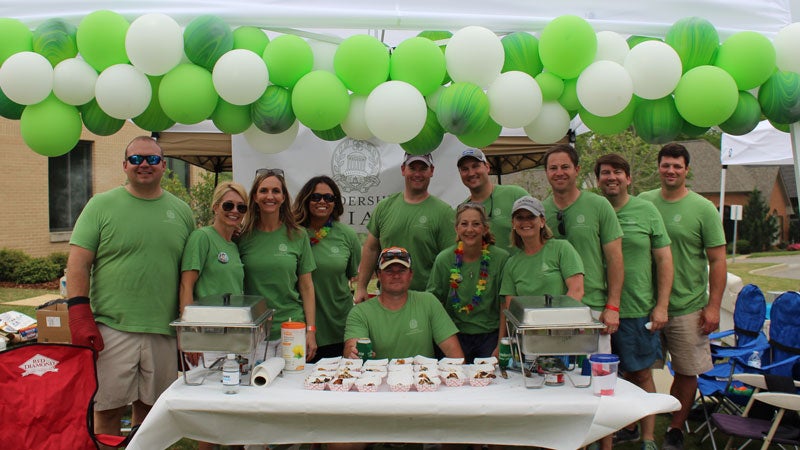 Leadership Vestavia Hills Basics
Leadership Vestavia Hills Basics
Leadership Vestavia Hills began in 1996 to bring together potential city leaders and assist them in becoming more aware of the social and economic issues that impact the community. Each annual LVH class works on projects aimed to improve the lives of Vestavia Hills and its citizens. Some are completed in the year, while others, like those featured in this article, span multiple years and/or go on to birth independent programs. A new LVH class begins each fall. Learn more at leadershipvestaviahills.com.

